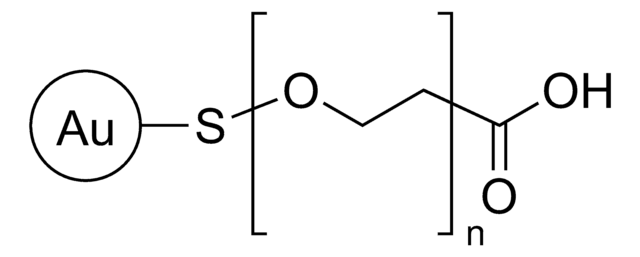Kluczowe dokumenty
765325
Gold nanoparticles
15 nm diameter, amine functionalized, PEG 5000 coated, OD 50, dispersion in H2O
Synonim(y):
Gold nanoparticles NH2 functionalized, Au NP NH2, Gold Colloid
About This Item
Polecane produkty
Materiały
PEG 5000
Poziom jakości
Formularz
dispersion in H2O
nanoparticles
opakowanie
poly bottle of 1 mL
OD
50
średnica
15 nm
pH
6.0-8.0 (25 °C)
rozpuszczalność
water: miscible
gęstość
1.00 g/cm3
λmaks.
520 nm
grupa funkcyjna
amine
temp. przechowywania
2-8°C
Szukasz podobnych produktów? Odwiedź Przewodnik dotyczący porównywania produktów
Opis ogólny
Zastosowanie
Cechy i korzyści
- A negatively charged siRNA-PEG complex, attached to positively charged GNPs, is easily cleavable in reductive cytosolic environment thus enabling the release of siRNA into cytosol.
- The PEG coating, decreases the cytotoxicity and increases efficiency of GNPs. PEG increases the stability of the nanoparticles and prevents agglomeration.
Kod klasy składowania
10 - Combustible liquids
Klasa zagrożenia wodnego (WGK)
WGK 2
Temperatura zapłonu (°F)
Not applicable
Temperatura zapłonu (°C)
Not applicable
Wybierz jedną z najnowszych wersji:
Certyfikaty analizy (CoA)
Nie widzisz odpowiedniej wersji?
Jeśli potrzebujesz konkretnej wersji, możesz wyszukać konkretny certyfikat według numeru partii lub serii.
Masz już ten produkt?
Dokumenty związane z niedawno zakupionymi produktami zostały zamieszczone w Bibliotece dokumentów.
Produkty
The recent emergence of a number of highly functional nanomaterials has enabled new approaches to the understanding, diagnosis, and treatment of cancer.
Biomaterials science involves the design and fabrication of smart materials for studying, directing, or mimicking biology. For successful integration of biomaterials in biological research, a meaningful understanding of biological systems is required.
Nasz zespół naukowców ma doświadczenie we wszystkich obszarach badań, w tym w naukach przyrodniczych, materiałoznawstwie, syntezie chemicznej, chromatografii, analityce i wielu innych dziedzinach.
Skontaktuj się z zespołem ds. pomocy technicznej


